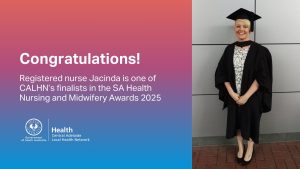Hundreds of South Australian burns patients are benefitting from the fundraising efforts of the Josh Deegan Foundation (JDF) each year, which is dedicated to supporting patient care at Royal Adelaide Hospital’s world-class Burn Unit.
Established to celebrate and honour the life of Adelaide teen, Josh Deegan, who was among 88 Australians killed in the terrorist attack at a Bali nightclub in 2002, the charity is now in its 20th year and has contributed more than $285,000 to the unit.
Royal Adelaide Hospital (RAH) Burn Unit Advanced Nurse Unit Manager, Natalia Adanichkin, said the JDF contributed towards the training and upskilling of dozens of regional and RAH staff nurses and therapists and the purchase of specialised burns patient equipment.
“One of the crucial ways JDF supports us is through the funding of nurses and allied health clinicians to attend professional development opportunities locally and interstate, including conferences and nursing seminars,” she said.
Natalia said regional health professionals and allied health clinicians were prioritised for ongoing training, as part of the RAH Burns Link program.
Upskilling for the rural nursing workforce ensured patients out of the metropolitan area received access to emergency management and treatment of burns and specialist wound care, resulting in shorter stays in hospital and minimising patient travel and time away from family.
“This is invaluable, as it is trains therapist and nurses in rural and remote areas in evidence-based burns management.
“We have little angels everywhere who are trained to use the specialised products used here at the RAH, so we can discharge patients earlier and the nurses are able to continue looking after them in the community with ongoing support from us via video link or telehealth.”
She said the support of the JDF would help the RAH Burn Unit achieve its aim of having a Burns Link nurse and therapist in each major regional area.
RAH Burn Unit Nurse Consultant, Stuart Harper, said the foundation also supported the purchase of equipment which aided recovery and outcomes of burns patients.
Specialised equipment funded by JDF included:
- Two special pressure relieving mattresses to prevent pressure ulcers and improve patient comfort, especially for larger injuries
- three blood pressure machines to improve clinical monitoring
- a pulse oximeter machine to improve clinical monitoring
- an electric chair that can be optimally positioned for patient comfort as well as to assist in the early stages of rehabilitation
- a patient lifter with weigh scale to facilitate patient transfers, provide clinical monitoring, and improve staff safety when transferring immobile patients
- a toe pressure machine.
Josh Deegan’s sister Elly, who volunteers for the charity, said she was proud of the JDF’s contribution over the past 20 years.
Starting an annual golf day 20 years ago to celebrate our beloved Josh, we never thought we would be where we are today,” Elly said.
“Having raised over $285,000 and knowing that’s changing lives now and for tomorrow is quite an overwhelming feeling.
“The impact that Josh’s legacy is making to so many South Australians is a tribute to the kind of person he was.
“Josh always supported others, he is our inspiration to be our best selves and being an avid sportsperson, he knew the value of fighting.
“Today, his perseverance is our ongoing commitment to supporting those fighting their own battles in the RAH Burn Unit and providing necessary funding for prevention and rehabilitation training for nurses and burns therapists across metropolitan and regional South Australia.”
Natalia said most young adult burns patients’ injuries were caused by flame including open fire, barbecue, or starting a fire with an accelerant, while elderly patients were most often injured through scalding accidents.
The treatment and management of burns patients had improved in the past decade, affecting the length of stay in hospital.
“Recently we had a patient with burns to 70 per cent of their body discharged after 7 weeks, to continue their rehabilitation in the community, however we can have patients stay with us for three to four months,” she said.



